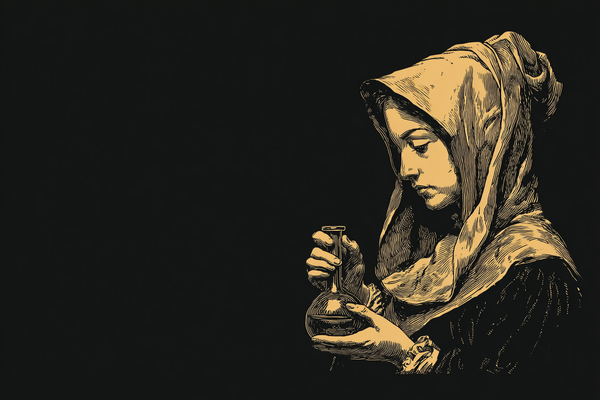The Naked Prophetess of St. Gallen

Winter, 1526. In and around St. Gallen, crowds trail a young maid from Appenzell named Verena (Frena) Baumann. She preaches visions, declares herself chosen, and—according to eyewitness chronicler Johannes Kessler—at one point even calls herself Christ and speaks of bearing the Antichrist. Wherever she goes, people gather, throw coins and even clothing into the street, and wait for signs. City magistrates hesitate: punish, persuade, or simply expel? The scene is strange to us, but it unfolded in a precise historical climate: a city remaking church and society at speed.
The city and its fault lines
St. Gallen in the 1520s was a textile powerhouse and a Reformation laboratory. Humanist physician Joachim Vadianbecame mayor in 1526 and steered the city toward the new evangelical order. Meanwhile Kessler’s popular Sunday "Lesinen" (public Bible readings) pulled Scripture off the pulpit and into workshops and kitchens. Laypeople argued doctrine, merchants funded printing, and old and new authorities competed for legitimacy. The air was thick with expectation and anxiety.
- Old thinking vs. new: Medieval sacramental culture was giving way to vernacular preaching, congregational singing, and the idea that the Bible—read by common folk—could refound society.
- Street-level religion: Prophecy, dreams, and apocalyptic talk spread alongside sober catechisms. Austria’s wars, the Peasants’ War (1525) nearby, and pamphlets about the Turkish threat all heightened an end‑times mood.
Enter the Anabaptists
Among the most controversial innovators were the Anabaptists ("re‑baptizers"). They insisted on believer’s baptism (no infant baptism), a church of visible commitment, and often separation from state coercion. In St. Gallen and Appenzell, Anabaptism emerged from lay Bible circles; some members practiced radical discipleship (simple dress, mutual aid, refusing oaths), while a prophetic fringe experimented with visions and sign‑acts. Women were present not only as hearers, but sometimes as prophetesses.
Verena (Frena) Baumann’s moment
Kessler’s chronicle places Frena/Verena Baumann—a young domestic servant from Appenzell—among several St. Gallen women who, for a season, led an ecstatic following. Together with Magdalena Müller (explicitly named a Täuferin/Anabaptist) and Barbara Mürgler, Verena gathered disciples, spoke through the night, claimed a circle of twelve, and at times proclaimed herself Christ. She alternately announced she would bear the Antichrist and called herself the great whore of Babylon (Revelation language turned inside‑out). The movement drew curious onlookers from town and countryside.
When the council finally intervened, Kessler says the authorities placed Verena in chains in the city’s hospital/guest‑house (Krankenherberge für Fremde) for six weeks. After refusing to go home to Appenzell, she was banished beyond St. Gallen’s jurisdiction. Her companions were turned over to their families and isolated; relapse could bring permanent expulsion.
“She gave herself out to be Christ … and the others believed it … ‘Whoever will follow the Lord, come!’” — paraphrased from Kessler, Sabbata
About the “naked” label: Later polemics relish lurid details about radical groups; Kessler’s account emphasizes crowds, trances, and the discarding of clothes and money as signs of renunciation. Whether this included staged public nudity in St. Gallen or simply dramatic shedding of garments, the point is the same: provocative sign‑acts that broke social norms to announce a new spiritual reality.
Why did this happen here?
Because everything was in motion. A few elements:
- Do‑it‑yourself Scripture
New lay access to the Bible produced confidence—and volatility. If truth seemed plain to common readers, traditional clergy looked like obstacles. In this climate, visions and prophecies claimed the same immediacy as Scripture. - Competing reform blueprints
Zwinglian pastors and magistrates in cities like Zurich and St. Gallen wanted an orderly Reformation: preaching, schools, poor relief, moral discipline. Anabaptists pushed for a church of convinced adults only; some prophetic groups moved faster and stranger—toward end‑times action. - Women and voice
In lay circles, especially on the Anabaptist edge, women sometimes preached or prophesied. Kessler explicitly notes women’s prophetic activity in 1526. The spectacle of female leadership made these episodes doubly controversial—and magnetic. - Europe‑wide tremors
Across the Empire, radical gestures multiplied: “naked truth” processions in the Netherlands (1535); apocalyptic experiments in Münster (1534–35); and, earlier, visionaries in Zwickau and Strasbourg. St. Gallen’s episode sits on that spectrum—earlier, smaller, but of a piece with it.
Vadian’s line: firmness without blood
Burgomaster Joachim Vadian embodied the city’s humanist‑magisterial approach: persuade where possible, restrain when necessary, and avoid spectacular punishments that make martyrs. In Verena’s case, the council opted for confinement and banishment, not corporal penalties. The policy aimed to cool the fever without igniting rebellion—an approach that let St. Gallen keep Reformation momentum while pushing back against Anabaptist extremes.
What to make of Verena now?
To modern readers, the claims sound delusional. Yet as a window into the time, Verena’s story is priceless. It shows ordinary people using the new tools of the Reformation—vernacular Bibles, lay meetings, spiritual autobiography—to rewrite their place in the world. In that flux, some fashioned sober congregations; others staged sign‑acts so bold they scandalized neighbors and terrified magistrates.
That mix—liberation and excess—echoes how many modern movements begin: intense ideals, do‑it‑yourself media, street theatre, fractures between moderates and radicals. Some participants found healthier, lasting paths; others burned out or were pushed out. But no one who stayed silent remade anything.
Timeline (select)
- 1525 — Anabaptist baptisms spread from Zürich; popular Bible gatherings expand in St. Gallen.
- 1526 — Vadian elected mayor; episodes of women’s prophecy in St. Gallen, including Verena Baumann, Magdalena Müller, Barbara Mürgler; city imposes confinement and banishment.
- 1531 — (Context) Zwingli dies at Kappel; Anabaptism persists eastward into Appenzell and beyond.
- 1534–35 — (Context) Münster’s apocalyptic experiment shocks Europe; rulers tighten control.
Key terms (reader’s guide)
Anabaptists: Sixteenth‑century movement advocating believer’s baptism and a voluntary, disciplined church; varied from pacifist communities to apocalyptic fringes.
Kessler’s Sabbata: A richly detailed St. Gallen Reformation chronicle (1523–39) by lay reformer Johannes Kessler, often our best local source.
Magisterial Reformation: City‑led, pastor‑and‑council model (Zwingli, Vadian) seeking orderly religious change through civic authority.
Sign‑act: A provocative, symbolic deed (tearing clothes, public repentance, “naked truth”) meant to preach without words.
Where did the Anabaptists go? Then & now
After the 1520s–30s: Repression in Swiss cities (Zurich, St. Gallen, Bern) pushed Anabaptists to define themselves and to move. In 1527 they issued the Schleitheim Articles, a short confession that set out believer’s baptism, church discipline (“the ban”), the Lord’s Supper as memorial, separation from coercive state power, non‑swearing of oaths, and nonviolence. In practice, the movement soon differentiated into several streams:
- Swiss Brethren → Mennonites. In the Low Countries, the priest‑turned‑reformer Menno Simons gathered a pacifist, disciplined wing that stabilized and spread across Europe; “Mennonite” became the family name for many communities.
- Amish (from Jakob Ammann, 1690s). A stricter Swiss‑Alsatian branch that insisted on strong shunning and plainness; most later migrated to Pennsylvania and other parts of North America.
- Hutterites (from Jakob Hutter, 1520s–30s). Communal Anabaptists who practiced community of goods; after long migrations through Moravia, Transylvania and Russia, they resettled almost entirely in Western Canada and the U.S. northern Plains.
- Later kin include the Mennonite Brethren (19th c.), and in the 20th c. the Bruderhof, who share classic Anabaptist convictions.
Migration arcs (very short): Swiss‑South German Anabaptists fanned into the Palatinate/Alsace, then to North America (1700s). Dutch‑North German Mennonites developed a separate line, with large colonies in Prussia/Russia(later moving to the Americas). Hutterites migrated in stages to Russia and then to Canada/USA (late 19th–20th c.).
Today: The global Anabaptist family (especially Mennonite bodies) numbers ~2 million baptized members across 80+ countries. Growth is strongest in Africa and Asia, while historic communities remain in Europe and North America. The Amish are concentrated in the U.S. and Canada; Hutterites live almost entirely in communal colonies in Western Canada and the U.S. Upper Midwest/West.
Afterword — the courage (and risk) of trying
Verena’s fame lasted months; St. Gallen’s Reformation reshaped centuries. Both were born of people trying—sometimes unwisely, often courageously—to live their convictions. If her gestures look absurd now, their energy—to test, to speak, to step outside the script—belongs to the same age that gave Europe lay Bibles, congregational song, and new ideas of conscience. The line between ridiculous and revolutionary is thin in every era.





